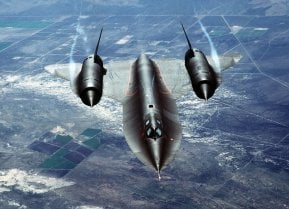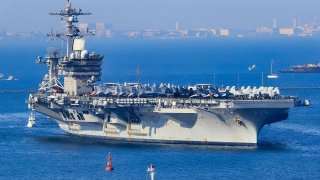How U.S. Navy Warplanes Landed on an Aircraft Carrier During a Typhoon
The incredible story of how all these airframes made it safely back to the flight deck was recently shared by one of the sailors stationed aboard the aircraft carrier as a maintenance worker.
Landing is one of the most difficult aspects of flight. Most airplanes require a long runway and relatively stable winds to attempt to land. Doing so at night requires runway lights, approach lights, and often instrument approaches.
For naval carrier pilots, however, many of these luxuries do not exist. The landing area on an aircraft carrier is about 300 feet long, even on the U.S. Navy’s newest supercarrier, the USS Gerald Ford. Pilots must make an arrested landing using a tailhook on their airplane to catch one of three to four wires strung across the flight deck. Should they miss, or “bolter,” they immediately go around — there is no hope of stopping by using brakes alone.
Night adds another dimension to arrested carrier landings. While shore-based aircraft have the benefit of other landmarks and local lighting, as well as approach lighting that can extend for over half a mile from the runway threshold, carrier pilots have only the lights of the carrier itself, and these can be tough to see in the immense blackness of the ocean at night.
Perhaps the most challenging aspect of carrier landings is a pitching deck. The ground is inherently stable, meaning as long as the pilot has flown a good approach to landing, there should not be any issues on touchdown. But in rough enough seas, a carrier’s flight deck can pitch and roll. Even if the pilot has flown a perfect approach, a flight deck falling away just as the plane is touching down creates a high likelihood of boltering.
Fliers on the Storm
In 1972, pilots were forced to land their airframes on an aircraft carrier amid a raging typhoon. With the USS Midway near Vietnam, a combination of F-4s, A-6s and A-7s were airborne when incoming weather was detected. The incredible story of how all these airframes made it safely back to the flight deck was recently shared by one of the sailors stationed aboard the carrier as a maintenance worker.
According to Willie Maddox, conditions were so harsh that the limited personnel allowed on the flight deck at the time were “tossed mercilessly” by the intense rolling of 60-foot waves and 100-mph winds. When the crewmen spotted the first airframe approaching the carrier to land, they knew the storm conditions left the pilot unable to make out the familiar lighting of the carrier’s landing area. Maddox remembered that the Naval Flight Officer was able to guide them toward the carrier by using radar and navigation instruments.
As detailed by Maddox: “The plane hit the deck and caught a wire. The tail hook, firmly pressed against the steel by 3000 pounds of force, dragged the wire as it slowed to a stop. The din was incredible, as it happened just 5 feet above my head, and the force of the arrestment shook the whole ship. The noise and brute force were routine parts of a carrier landing, and on this night they were welcome announcements of the first safe recovery.
Guided by precision signals from the expert flight deck crew, the plane taxied to the bow. The landing area was quickly clear and made ready for the next aircraft, and we could already see its landing light piercing the stormy night sky.”
About the Author
Maya Carlin is an analyst with the Center for Security Policy and a former Anna Sobol Levy Fellow at IDC Herzliya in Israel. She has by-lines in many publications, including The National Interest, Jerusalem Post, and Times of Israel. You can follow her on Twitter: @MayaCarlin.


